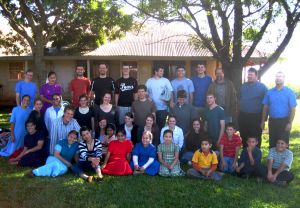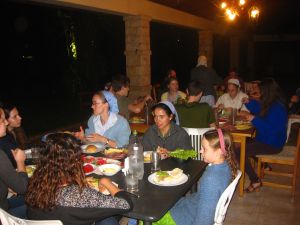From the classroom to the colonies, students gain a new perspective on Anabaptism in Paraguay

(Photo courtesy of Mara Weaver)
Not everyone travels 5,000 miles to go to class. But during May term this year, a group of Goshen College students made their way to Paraguay to experience Anabaptist culture, identity and history in South America firsthand.
Goshen College Professor of History John D. Roth led 17 students in an exploration of the different Anabaptist cultures of Paraguay. The class trekked from the capital city of Asunción to Mennonite colonies in the Gran Chaco and in eastern Paraguay during their three-week learning tour of the country.
Roth has led three May term classes in Europe, tracing the beginnings of the Anabaptist movement in Germany, Switzerland and the Netherlands, but this was his first time leading an Anabaptist history class in South America. The new location arose from his shifting focus to global Anabaptism and his recent travels to emerging Anabaptist locations in Central and South America, Asia and Africa.
“I have tried to reorient my understanding of Anabaptism from a focus primarily on the 16th century, German-speaking tradition to its contemporary expression in 85-plus different countries,” Roth said. “I have found Paraguay to be an ideal “laboratory” for thinking through this new perspective.”
According to Roth, at least 20 different Anabaptist-Mennonite groups have settled in Paraguay, some with deep roots in traditional European Anabaptism. They preserve a strong sense of their ethnic, cultural and religious identity by living in relatively isolated colonies far from Asunción. Many of these groups came to Paraguay from Russia, Canada or the United States, bringing with them some elements of their tradition, while also absorbing Paraguayan aspects of life.
Other Anabaptist groups in the country have emerged as a result of local missions among native Paraguayans, who generally speak Spanish or Guaraní, a native dialect, and have adopted worship styles similar to the evangelical traditions around them.
“Paraguay is a microcosm of the diversity and variety of the global Anabaptist-Mennonite church today,” Roth said.
For Mara Weaver, a 2013 graduate with a history degree from Bloomington, Ill., the class provided an opportunity to learn more about her Anabaptist heritage in a unique South American setting. “I have an interest in Anabaptist-Mennonite history and hadn’t had a chance to take an Anabaptist history course on campus,” she said. “In addition to that, I knew next to nothing about Mennonites in Paraguay before the trip, so I figured it would be a great opportunity to learn a lot about an unfamiliar subject.”
While Roth kept the class busy with readings, journal assignments, discussions and special projects, the main mode of learning came from the group’s experiences both in the capital and visiting Mennonite and Amish colonies throughout the country.
“I was expecting more of a history class – and we certainly did learn a lot about Anabaptist history and Paraguayan history, as well as the history of the Mennonite groups in Paraguay – but quickly realized that it was much more than that,” Weaver said. “For me, the way that I approached the subject matter was very much shaped by the fact that we were not just studying people and theological movement of the past. We were interacting with and living with the people at the heart of our study.”

(Photo courtesy of Mara Weaver)
After arriving in Asunción, the class spent six days exploring the city, learning about the history of Anabaptists in Paraguay from local leaders and reflecting on their experiences. They then travelled to Menno Colony, a settlement founded in 1926 in the Paraguayan Chaco by Russian Mennonite immigrants. There they stayed with host families and experienced life and culture in the colony firsthand.
After a few days back in Asunción, which included a visit to Paraguay’s largest prison that is partly maintained by one of the Mennonite churches in Asunción, the class made its way to east Paraguay. There they stayed near the Sommerfeld Colony and visited different groups in the area, again staying with Mennonite and Beachy Amish host families.
“I loved the opportunity to stay with host families,” said Ben Hochstetler, a sophomore from Goshen. “In both places I was blessed with tremendous host families who helped provide answers to my questions and who treated our group with incredible hospitality.”
For Weaver, the class was a chance to not only explore history, but her own faith as well. “I often found that my reflections on the content of the course warranted quite a bit of introspection and pushed me to nail down some of my own theological beliefs, as well as challenging me to question my own ethnic and cultural traditions and practices,” she said.
Hochstetler had a similar experience. “I find it fascinating to see how some of the basic Mennonite core convictions that I hold as a Mennonite in North America have been shaped and almost reinterpreted by the Mennonites that live in Paraguay,” he said.
Roth was impressed by the energy and insight of the students. “Their questions, their journal reflections, their individual projects were all amazingly insightful; and it seemed as if we were engaged in conversations about our experiences at every hour of the day,” Roth said. “I have never been more proud of Goshen College students. They were eager to think in interdisciplinary ways, moving across theology, ethics, history, sociology and anthropology as we tried to understand the diversity of contexts.”




